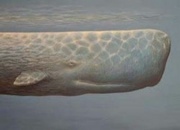Difference between revisions of "Spermaceti"
| Line 10: | Line 10: | ||
== Physical and Chemical Properties == | == Physical and Chemical Properties == | ||
| − | Soluble in chloroform, ether, carbon disulfide, oils, hot ethanol; | + | * Soluble in chloroform, ether, carbon disulfide, oils, hot ethanol; |
| − | + | * Saponification no. = 120-136 | |
| − | Saponification no. = 120-136 | + | * Iodine no. = 3.0-4.4 |
| − | + | * Acid value = 2.0-5.2 | |
| − | + | * Melting Point = 40 - 50 C | |
| − | + | * Density = 0.905-0.945 g/ml | |
| − | + | * Refractive Index = 1.4330-1.440 | |
| − | |||
| − | |||
| − | |||
| − | |||
| − | |||
| − | |||
| − | |||
| − | |||
== Comparisons == | == Comparisons == | ||
Latest revision as of 14:59, 2 June 2022
Description
A white, translucent wax obtained from the oil in the head cavity of the sperm whale, Physeter catadon or P. macrocephalus. Spermaceti is collected from the cooled sperm oil, then washed with hot water and pressed to remove residual oil. The solid mass is then mixed with a slightly alkali solution and cast into molds. Spermaceti has been used since at least the 15th century for ointments, candles, castings, soaps, and leather dressing. It is composed of a mixture of fatty acid esters (cetyl palmitate) and long-chain alcohols. Most spermaceti wax currently on the market is made synthetically.
Synonyms and Related Terms
Physeter macrocephalus; Physeter catadon; espermaceti (Esp.); spermaceti (Fr.); spermaceti (It); cetaceum; white amber; spoermaceti wax
Physical and Chemical Properties
- Soluble in chloroform, ether, carbon disulfide, oils, hot ethanol;
- Saponification no. = 120-136
- Iodine no. = 3.0-4.4
- Acid value = 2.0-5.2
- Melting Point = 40 - 50 C
- Density = 0.905-0.945 g/ml
- Refractive Index = 1.4330-1.440
Comparisons
Resources and Citations
- G.S.Brady, Materials Handbook, McGraw-Hill Book Co., New York, 1971 Comment: p. 55 and 748
- Ralph Mayer, A Dictionary of Art Terms and Techniques, Harper and Row Publishers, New York, 1969 (also 1945 printing) Comment: melting point = 41-44C
- Michael McCann, Artist Beware, Watson-Guptill Publications, New York City, 1979
- Matt Roberts, Don Etherington, Bookbinding and the Conservation of Books: a Dictionary of Descriptive Terminology, U.S. Government Printing Office, Washington DC, 1982 Comment: melting point = 40-44C
- Dictionary of Building Preservation, Ward Bucher, ed., John Wiley & Sons, Inc., New York City, 1996
- John S. Mills, Raymond White, The Organic Chemistry of Museum Objects, Butterworth Heineman, London, 2nd ed., 1994
- The Merck Index, Martha Windholz (ed.), Merck Research Labs, Rahway NJ, 10th edition, 1983 Comment: entry 8892
- The American Heritage Dictionary or Encarta, via Microsoft Bookshelf 98, Microsoft Corp., 1998
- Encyclopedia Britannica, http://www.britannica.com Comment: "sperm oil." Accessed 3 Jan. 2005.
- Art and Architecture Thesaurus Online, http://www.getty.edu/research/tools/vocabulary/aat/, J. Paul Getty Trust, Los Angeles, 2000
- CRC Handbook of Chemistry and Physics, Robert Weast (ed.), CRC Press, Boca Raton, Florida, v. 61, 1980 Comment: melting point = 42-50, density=0.950-0.945, ref. index = 1.440, iodine value=4.8-5.9, acid value = 20.-5.2, saponification value = 108-134
